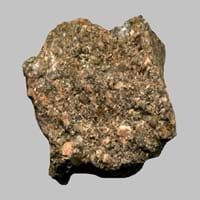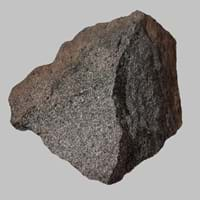Definition
Arkose is a sedimentary rock, specifically a type of sandstone containing at least 25% feldspar
Websterite is ultramafic and ultrabasic rock that consists of roughly equal proportions of orthopyroxene and clinopyroxene. It is a special type of pyroxenite.
Origin
France
Webster, North Carolina
Discoverer
Alexandre Brongniart
Unknown
Etymology
From Auvergne region of France used by a French geologist Alexandre Brongniart in 1826 who applied this term to some feldspathic sandstones
From the town of Webster located in North Carolina
Class
Sedimentary Rocks
Igneous Rocks
Sub-Class
Durable Rock, Hard Rock
Durable Rock, Hard Rock
Group
Not Applicable
Plutonic
Other Categories
Coarse Grained Rock, Opaque Rock
Coarse Grained Rock, Opaque Rock
Texture
Clastic
Clastic, Granular, Phaneritic, Porphyritic
Color
Reddish Brown
Black to Grey, Bluish - Grey, Dark Greenish - Grey, Green, Light Greenish Grey
Durability
Durable
Durable
Scratch Resistant
Yes
Yes
Appearance
Rough and Dull
Layered, Banded, Veined and Shiny
Interior Uses
Decorative Aggregates, Homes, Interior Decoration
Countertops, Decorative Aggregates, Entryways, Floor Tiles, Flooring, Interior Decoration
Exterior Uses
Paving Stone, Office Buildings
As Building Stone, As Facing Stone, Garden Decoration, Paving Stone
Other Architectural Uses
Whetstones
Curbing
Construction Industry
Cement Manufacture, Construction Aggregate, for Road Aggregate, Production of Glass and Ceramics, Raw material for the manufacture of mortar
As Dimension Stone, Building houses or walls, Cement Manufacture, Construction Aggregate, for Road Aggregate
Medical Industry
Not Yet Used
Not Yet Used
Antiquity Uses
Artifacts, Sculpture, Small Figurines
Artifacts
Commercial Uses
In aquifers, Soil Conditioner, Source of Magnesia (MgO), Tombstones
Cemetery Markers, Commemorative Tablets, Creating Artwork, Laboratory bench tops, Jewelry, Sea Defence, Tombstones
Types
Not Available
Not Available
Features
Available in Lots of Colors and Patterns, Generally rough to touch, Is one of the oldest rock
Generally rough to touch, Is one of the oldest rock
Archaeological Significance
Monuments
Not Yet Used
Not Yet Used
Famous Monuments
Not Applicable
Data Not Available
Sculpture
Used
Not Yet Used
Famous Sculptures
Data Not Available
Data Not Available
Pictographs
Not Used
Not Used
Petroglyphs
Not Used
Not Used
Figurines
Used
Not Yet Used
Formation
Arkose rock forms from the weathering of feldspar-rich igneous or metamorphic rock, most commonly granitic rocks, which are primarily composed of quartz and feldspar.
Websterite can be formed as cumulates in ultramafic intrusions by accumulation of pyroxene crystals at the base of the lava chamber.
Mineral Content
Calcite, Clay, Clay Minerals, Feldspar, Micas, Quartz
Amphibole, Augite, Bronzite, Chromite, Diopside, Enstatite, Garnet, Hornblende, Hypersthene, Magnetite, Pyroxene
Compound Content
Aluminium Oxide, CaO, Iron(III) Oxide, Potassium Oxide, MgO, Sodium Oxide, Silicon Dioxide
Aluminium Oxide, CaO, Chromium(III) Oxide, Iron(III) Oxide, Potassium Oxide, MgO, Sodium Oxide, Silicon Dioxide, Sulfur Trioxide
Types of Metamorphism
Not Applicable
Burial Metamorphism, Impact Metamorphism
Types of Weathering
Biological Weathering, Chemical Weathering, Mechanical Weathering
Biological Weathering, Chemical Weathering, Mechanical Weathering
Types of Erosion
Coastal Erosion, Glacier Erosion, Water Erosion, Wind Erosion
Chemical Erosion, Coastal Erosion, Glacier Erosion, Water Erosion, Wind Erosion
Grain Size
Coarse Grained
Coarse Grained
Fracture
Conchoidal
Uneven
Streak
White
White, Greenish White or Grey
Porosity
Highly Porous
Less Porous
Luster
Dull
Dull to Vitreous to Submetallic
Cleavage
Not Available
Irregular
Toughness
Not Available
Not Available
Specific Gravity
0
3.2-3.5
Transparency
Opaque
Opaque
Density
Not Available
3.1-3.6 g/cm3
Resistance
Heat Resistant, Impact Resistant, Pressure Resistant
Impact Resistant, Pressure Resistant, Wear Resistant
Deposits in Eastern Continents
Asia
China, India, Kazakhstan, Mongolia, Russia, Uzbekistan
India, Russia
Africa
Namibia, Nigeria, South Africa
South Africa
Europe
Austria, Denmark, Germany, Great Britain, Netherlands, Norway, Poland, Sweden, Switzerland, United Kingdom
Germany, Greece, Italy, Scotland, Turkey
Others
Greenland
Greenland
Deposits in Western Continents
North America
Canada, USA
Canada, USA
South America
Brazil
Brazil, Colombia, Venezuela
Deposits in Oceania Continent
Australia
New South Wales, New Zealand
New Zealand, Queensland
All about Arkose and Websterite Properties
Know all about Arkose and Websterite properties here. All properties of rocks are important as they define the type of rock and its application. Arkose belongs to Sedimentary Rocks while Websterite belongs to Igneous Rocks.Texture of Arkose is Clastic whereas that of Websterite is Clastic, Granular, Phaneritic, Porphyritic. Arkose appears Rough and Dull and Websterite appears Layered, Banded, Veined and Shiny. The luster of Arkose is dull while that of Websterite is dull to vitreous to submetallic. Arkose is available in reddish brown colors whereas Websterite is available in black to grey, bluish - grey, dark greenish - grey, green, light greenish grey colors. The commercial uses of Arkose are in aquifers, soil conditioner, source of magnesia (mgo), tombstones and that of Websterite are cemetery markers, commemorative tablets, creating artwork, laboratory bench tops, jewelry, sea defence, tombstones.










